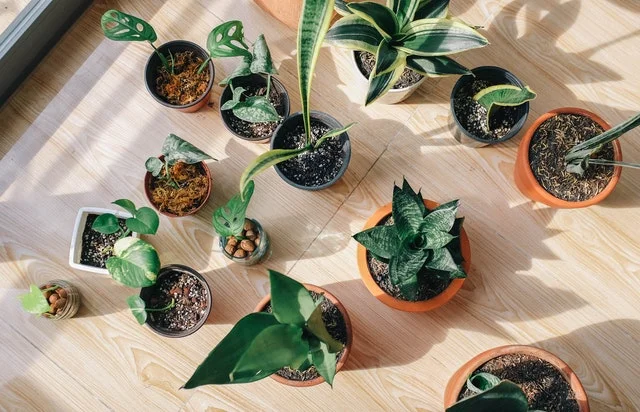Table of Contents
Introduction
The Snake Plant varieties sometimes called Mother in Law’s Tongue is a hardy clump-forming plant with upright sword-shaped leaves up to 1.3 meters long and banded in silvery-grey and green. In the tropics, it displays small white flowers.
These plants can be grown indoors, but look at their best when grouped in your garden.
They are very hardy and seldom attacked by disease making them a popular choice, and they don’t require much attention from the home gardener. If grown in direct sunlight the colors in the leaves are more pronounced.
Snake Plant Varieties
1.Sansevieria trifasciata is one of the common varieties of Snake Plant, and there are 23 different types that you can grow indoors, and they are very low maintenance and also absorb toxins from the air.
2.Sansevieria Trifasciata Twist The pointy leaves twist from the top, and it is slow-growing . Looks like the other one only twisted.
3.Sansevieria Golden Hahnii A golden dwarf Snake Plant that grows up to 10″ tall. This creamy-looking plant is ideal for a coffee table.
4.Sansevieria Futura Robusta Has short broad leaves and silver-green foliage, grows around 24″ high.
5.Sansevieria Black Gold An attractive black gold plant with broad leaves growing to about 30-35 inches high.
6.Sansevieria Cylindrica Green and grows tall at 20-24 inches.
7.Sansevieria Laurentii Dark green leaves with yellow borders and has lovely zig-zag stripes. Can grow to 24 inches.
8.Sansevieria Bantel’s SensationThis is a lovely indoor plant with white stripes on its green leaves, growing to 32 inches tall.
9.Sansevieria Desert Known as Rhino Grass with pointed leaves this is a native of the Kalahari desert that grows to 24 inches tall.
10.Sansevieria Moonshine Silvery green leaves, this is a lovely plant and needs nearly no attention.
11, Sansevieria masoniana Mason Congo Looks like a whale fin with stunning green foliage. Can grow to 45 inches.
There are many more snake plants, and they are all very forgiving of neglect, and do well on minimal care.
Snake Plant Varieties: How to care for Them
The Snake Plant thrives on indirect sunlight, and not too much water, especially during the winter.
One lot of general fertilizer every season should be enough for them and will keep the plant growing and looking healthy.
How to Grow Your Snake Plant
Your plant will grow easily from cuttings. Divide the roots for propagation with rhizomes this is the easiest way. The rhizomes are then planted in the garden for easy growth.
Once your plant is growing don’t give it too much water, as it is susceptible to rot. They actually handle the dry air very well and they are one of the few house plants that you don’t need to increase humidity for. Keep the plant away from really cold conditions.
Watering Your Snake Plant
Rot is the Snake Plant’s main risk factor, so not too much water. Let the plant dry out thoroughly before you water it. if you forget to water it for 8 weeks it will probably survive.
Light Requirements for your Snake Plant Varieties
The plant prefers medium light, they will tolerate low light. In a low-light area, you will notice that the leaves become darker. Keep your Snake Plant out of direct sunlight, as you don’t want them to get sunburnt.
Pests
The Snake Plant can get mealybugs, which you can get rid of. Mealybugs are common indoors and can spread quite quickly. They can be removed by spraying them with 70% alcohol spray, you need to do this quickly before they spread further.
Continue to spray every day until you are sure that the bugs have gone. With some plants soap and water, spray works for mealybugs, because the Snake Plant is hardy, the alcohol spray is a better option.
Propagation of Snake Plant Varieties
When propagating your snake plant use a cactus-type potting mix as your rooting medium, and try the leaf method of propagation. The other main method is rhizomes that spread underground and are usually successful.
After a while, the rhizomes will start sprouting. Another method of propagation is to divide the plant, if it is quite a large plant this works well.
Where did the Snake Plant come from?
The Snake Plant was native to Tropical West Africa from Nigeria to the Congo. The leaves are often arranged in a Rosette around the growing point and foliage varies.
The soft-leafed species are from tropical climates and the harder leaves from arid climates.
The hard leafed species have adapted to survive the desert including growing thicker leaves for water storage and reducing moisture loss. Some species have a greenish-white flower, in Summer.
In Africa, the leaves of sansevieria species are used for fiber production and made into bandages.
Ornamental Uses For Snake plant Varieties
In China, the Snake Plant is kept in a pot and decorated with dragons and phoenixes, growth is slow and the plant will last in this state for many years.
Because the Snake Plant is a tough plant, it has been used on many film sets both in Hollywood and internationally. Because the leaves of the plant grow upwards, it can also be used for Feng Shui.
Benefits of Snake Plants
- Cleans the air better than most plants in the house.
- Removes excessive carbon monoxide.
- It releases oxygen into the air and filters toxins out of the air.
- It looks neat and symmetrical
- It is said to be effective against allergies
- Has a protective Feng Shui
- Is a low maintenance plant
- Needs very little water.
Conclusion
There is a variety of Snake Plant for everyone, and the good news is that they all require very little care.
When you are going to purchase your Snake Plants, buy about six different varieties, bring them home, and group them together in their varying shades of green and different heights.
This will give you a very attractive arrangement of plants and is the best way to display them. Friends will comment on your grouping design, as just one alone does not look the same.


